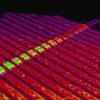Researchers at Oregon State University have managed to use zinc tin oxide to create cheaper, transparent memristors. A Memristor is a type of circuit component that can remember how much current has passed through it, and can save data even when the current is turned off. The technology holds promise for the creation of storage devices superior to solid state disks and faster memory technologies, as well as the merging of storage and memory into a single device that enables instant-on computing.
HP has teamed up with Hynix to commercialize memristors in the form of ReRAM (resistive RAM), but the company's technology requires relatively expensive titanium dioxide. The new memristor created by the Oregon State University researchers promises cheaper production cost, and is also transparent.'Flash memory has taken us a long way with its very small size and low price,' explained John Conley, a professor in the OSU School of Electrical Engineering and Computer Science, of his team's work, 'but it's nearing the end of its potential, and memristors are a leading candidate to continue performance improvements.'As Conley's comments suggest memristors are believed to be the next big thing in solid-state storage products, combing the benefits of non-volatile flash storage with performance approaching that of volatile dynamic RAM.
Their low power draw and high performance make them tempting for mobile devices, but the technology could also spell a sea change in the way computers operate by allowing the same device to be used as dynamic RAM and long-term storage without sacrificing performance.
Scientists create cheaper to produce memristor technology


